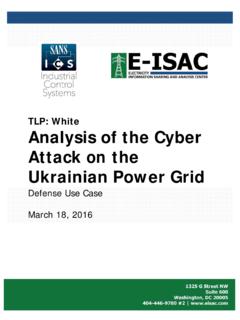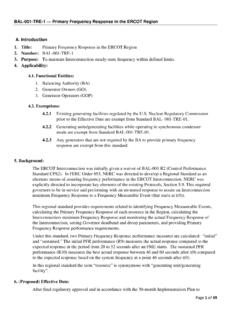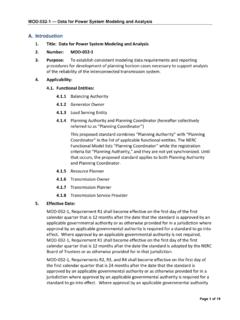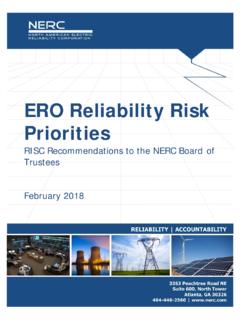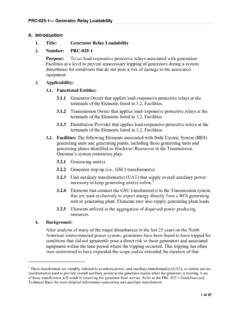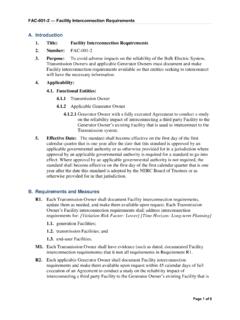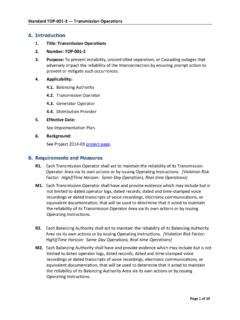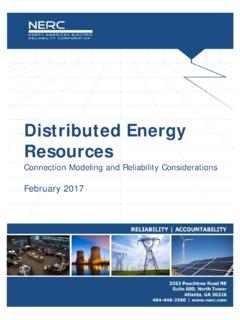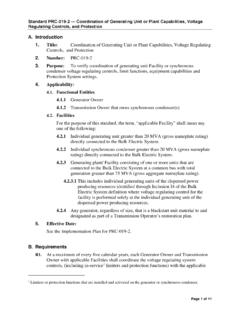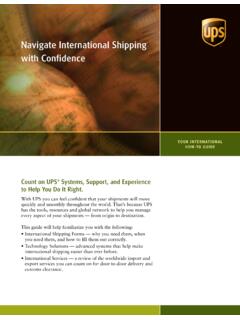Transcription of Distributed Energy Resources
1 Distributed Energy Resources Connection Modeling and Reliability Considerations February 2017. nerc | Report Title | Report Date I. Table of Contents Preface .. iii Executive Summary .. iv Introduction .. vi Chapter 1: Definition of Distributed Energy Resources ..1. Chapter 2: Reliability Considerations for DER ..3. DER and Potential Risks to Reliability ..4. Chapter 3: Data and Modeling for DER ..6. Data Requirements and Information Sharing at the T-D Interface ..6. DER Modeling for Bulk Power System Planning and Operations ..6. Steady-State Studies ..9. Dynamic Studies .. 11. Chapter 4: Characteristics of Nonsynchronous DER .. 16. Background .. 16. Voltage Ride-Through (VRT) and Frequency Ride-Through (FRT) Characteristics and Consequences.
2 16. California Rules for DER .. 20. Chapter 5: Previous Work of the nerc IVGTF Task Force .. 23. Chapter 6: nerc Reliability Standards .. 25. Background .. 25. Review of Existing nerc Standards .. 25. Chapter 7: Recommendations .. 27. Appendix A: Typical Connection of DER .. 28. Appendix B: Operations and Long-Term Planning .. 33. Appendix C: Review of Existing nerc 37. Appendix D: Transmission-Distribution Interface .. 39. Task Force Membership .. 40. References .. 41. nerc | Distributed Energy Resources Task Force Report | February 2017. ii Preface The North American Electric Reliability Corporation ( nerc ) is a not-for-profit international regulatory authority whose mission is to assure the reliability and security of the bulk power system (BPS) in North America.
3 nerc . develops and enforces Reliability Standards; annually assesses seasonal and long term reliability; monitors the BPS through system awareness; and educates, trains, and certifies industry personnel. nerc 's area of responsibility spans the continental United States, Canada, and the northern portion of Baja California, Mexico. nerc is the Electric Reliability Organization (ERO) for North America, subject to oversight by the Federal Energy Regulatory Commission (FERC) and governmental authorities in Canada. nerc 's jurisdiction includes users, owners, and operators of the BPS, which serves more than 334 million people. The North American BPS is divided into eight Regional Entity (RE) boundaries as shown in the map and corresponding table below.
4 The North American BPS is divided into eight RE boundaries. The highlighted areas denote overlap as some load-serving entities participate in one Region while associated transmission owners/operators participate in another. FRCC Florida Reliability Coordinating Council MRO Midwest Reliability Organization NPCC Northeast Power Coordinating Council RF ReliabilityFirst SERC SERC Reliability Corporation SPP RE Southwest Power Pool Regional Entity Texas RE Texas Reliability Entity WECC Western Electricity Coordinating Council nerc | Distributed Energy Resources Task Force Report | February 2017. iii Executive Summary The North American electric power system is transforming to a resource mix that relies less on coal and nuclear while integrating more natural gas, wind, solar, Distributed generation, and demand response Resources .
5 The nerc Essential Reliability services Working Group (ERSWG) is studying this transformation in the broader context of monitoring grid reliability and resiliency. Additionally, as noted in the ERS Framework Report 1 in 2015, Distributed Energy Resources (DER) are a rapidly growing part of this transformation. This report discusses the potential reliability risks and mitigation approaches for increased levels of DER on the BPS. At the distribution level, the potential impacts of DER are fairly well understood in the industry, but the translation of these impacts to the BPS has been studied less. This report discusses the challenges as well as the steps forward for reliably integrating higher DER penetrations.
6 In certain areas, DER are numerous and embedded within a distribution system that has traditionally been viewed as a relatively passive load resource on the BPS, but this will no longer be a valid assumption with the integration of more DER on the electric system. In addition, newer DER technologies are capable of providing advanced support services that will be needed as the transition from conventional synchronous Resources to nonsynchronous inverter-based Resources continues. It is paramount that nerc and the industry understand DER. functionality and develop a set of guidelines to assist in modeling and assessments such that owners/operators of the BPS can evaluate and model DER in the electric system.
7 Data requirements and information sharing across the transmission-distribution (T-D) interface should also be further evaluated to allow for adequate assessment of future DER deployments. This report does not make an assessment of the capability of DER versus conventional Resources ; it is only meant to help entities, regulators, and policy makers better understand the differences between DER and conventional generation and how DER affect the BPS. DER will increasingly have state-of-the-art capabilities for active power control and reliability services . However, there are differences in how DER are deployed within the grid and the characteristics of the services and responses that they provide, so these differences must be understood and modeled appropriately.
8 As a result, this report explains how practices for modeling and operating the BPS may be enhanced to reflect future system characteristics. Simultaneous efforts to improve DER interconnection standards, such as proposed changes to the Institute of Electrical and Electronics Engineers IEEE 1547 2, will assist in establishing criteria and requirements for interconnection of DER to electric power systems. The ability to accurately model the power system is important given the highly complex and interconnected nature of the power grid. System modeling is critical for power grid operations and planning for both normal operations and disturbances to ensure reliable operation of the BPS. All components of the system must be represented in the models, either directly or in an aggregated way, with sufficient fidelity to enable the model to provide meaningful and accurate simulations of actual system performance.
9 A modular approach to represent DER in BPS. studies, with some level of data validation, may ensure accurate representation of the Resources for the specific BPS study type. While dynamic models for different DER technologies are available, limited existing knowledge and experience of modeling DER in system planning studies and operating with higher penetration DER levels will require future collaborative research, knowledge exchange, and learning. Even though load and DER reside behind-the-meter the modeling for each of these respective network elements requires a different set of data. As the penetration level of DER increases, the classical transmission model of distribution system load (netted generation and load) is not valid; the unique characteristics of DER must be modeled separately.
10 This is distinct from tariff and ratemaking issues ( , net metering, time-of-use rates, value 1 nerc Essential Reliability services Task Force Measures Framework Report; November 2015. 2 IEEE 1547 Standard for Interconnecting Distributed Resources with Electric Power Systems nerc | Distributed Energy Resources Task Force Report | February 2017. iv Executive Summary of solar methods, etc.). Data for DER modeling and verification purposes must be collected, and the industry should determine the level of granularity which corresponds to the future BPS modeling needs. The ERSWG has also discussed the importance of continuously maintaining the balance between demand and generation for balancing areas. These ramping and balancing activities may become more challenging for regions with high levels of DER as these activities will require Resources located on the BPS as well as the distribution system, and the distribution system may not be visible to or controlled by the BPS operator.
